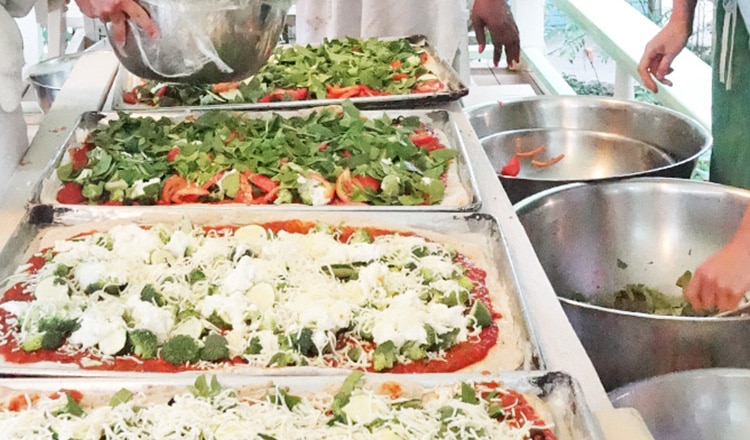Sivananda Bahamas Blog
Expand Your Horizons …
Our Blog
Ganesha’s Famous Pizzas
On graduation day for students of the Sivananda Teacher Training Course, the entire ashram is hopping with excitement as dinnertime approaches. This is the night that Ganesha, a longtime staff member, makes pizza for dinner.
These are no ordinary pizzas. Churning out as many as 38 trays of pizza, each big enough to generously feed 10 people, this occasional chef has fine-tuned his skills over the last nine years, making herbed crusts and cheese-strewn pies filled with fresh vegetables and spices.
Ganesha been acquiring these skills long before the ashram came into his life. “I tried to make pizza for the first time when I was 13 or 14 years old, out of a box,” he says. “I did those throughout university and only began to make my own crust when I was in my 20s living in Europe.”
In Munich, he says, pizza was surprisingly expensive. “And when I first moved there, I didn’t have good enough German to call on the phone and order a pizza. So I found a pizza dough recipe and started doing it myself.” Then, on his second or third visit to the ashram, he was in the morning kitchen when whoever was making pizza for the TTC graduation dinner was really uncertain about it. “So I volunteered to help and it went well. And I became the pizza maker.”
The secret to his pizza, Ganesha says, is to be generous. “Be generous with the dough, be generous with the spices, with the toppings, with the cheese. Not one olive every 15 centimetres, pile it on. And because we’re so many people, I coat a lot of cheese on top so people aren’t holding up the line by stopping to choose one pizza over another.”
The dozens of pizzas, made with the help of the kitchen staff, are mostly Mediterranean style, he says — a classic is spinach, black olives, tomato and dots of ricotta cheese, but there can be as many combinations of vegetables as their are pizza dressers. “We use fresh basil and fresh cilantro. Sometimes I just mix that in with the cheese. You have to be careful with fresh herbs and baking, they can’t be in the oven too long.”
These variations on vegetables and cheese combinations — he often mixes cheddar and mozzarella — are always meatless. Sun-dried tomatoes make a nice meat substitute on pizza, Ganesha says, and the pizzas are usually sprinkled with lots of green and red peppers. “Sometimes I’ll throw in some jalapenos. And pineapple — I’m in the pineapple-is-good-on-pizza crowd. We usually get one Italian on the pizza crew and I make them use pineapple on it, get them to expand their world.”
The process to make vegetable pizzas begins with the dough, which is started in late morning and left to rise. Flour, yeast and spices are combined, “whatever we have that’s green — oregano, parsley, basil, rosemary, a little bit of dill, some thyme, maybe a bit of crushed red pepper, salt.” Mixed with oil to bind and then water, the dough should become soft and elastic, easy to manipulate, not sticking to the sides of the bowl.
A few hours later, after the dough in a covered bowl in a cool room has doubled in size, it is divided into balls then rolled on a floured surface as the kitchen pizza team cuts up the toppings. “We spread out the dough, then roll it with a bit of flour until it becomes rectangular in shape,” he says. It is placed on cookie sheets that are lightly oiled then sprinkled with flour or cornmeal. Once rolled out, dough is pricked all over with a bowl, then begin to sauce and top the pizza.
The sauce, made from tomato paste, water and herbs, is cooked on high heat for five minutes with a bit of salt added for flavour. It is spooned lightly over the dough before the toppings and cheese are added. “We get all the toppings in the room and then we just go for it,” Ganesha says. “There’s no right or wrong.”
He prefers the Mediterranean pizza and a combination of pineapple and jalapeno, topped with cheese mixed with basil, a tiny bit of black pepper and, for a select few, some crushed red pepper. “I’ve used thinly sliced sweet potato a few times, thinly sliced zucchini and occasionally, a special treat like roasted asparagus tips and cream cheese. That’s a great one.”
Pizza dough (makes one 12-inch pizza)
3 ¼ to 3 ¾ cups all purpose flour
2 teaspoons instant yeast
1 ½ teaspoons salt
Dried herbs (Ganesha recommends 5 tablespoons)
1 ⅓ cups very warm water
⅓ cup oil
Pizza topping
½ to 1 cup sauce
1 to 2 cups (4 to 8 ounces) shredded mozzarella cheese
Toppings as desired
Instructions
Preheat oven to 475 to 500°F.
Combine dry ingredients including yeast in a large bowl. Add oil and mix again, then slowly mix in half the water, adding the remaining slowly until the dough pulls away from the bowl and doesn’t stick to your hands. Place dough in oiled bowl, cover tightly with dark wrap and leave to rise for an hour in a dark, cool spot. On a floured surface, press dough, and roll into the appropriate shape.
Cover with sauce, toppings and cheese. Bake at high heat until cheese is golden and crust is lightly browned.
Pat dough with floured hands to fill greased pizza pan or baking sheet. OR roll dough on a floured counter to 12-inch circle; place in greased pizza pan or baking sheet. Form a rim by pinching the edge of the dough.
Bake crust on lowest oven rack for 10 to 13 minutes, until cheese is bubbly and crust is browned.
Remove from oven. Spread with pizza sauce. Top with desired toppings and sprinkle with cheese.








